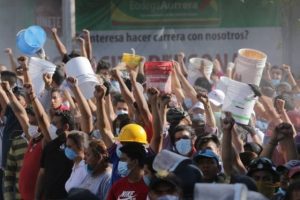El Sismo en México
El martes el 19 de septiembre, La Ciudad de México sufrió un sismo en que al menos 225 personas murieron y miles más fueron afectados. Ocurrió 2 semanas después de otro sismo que afectó mucho la Costa pacífica, y en una coincidencia rara, ocurrió 32 años exactos desde el sismo en 1985 en que más de 10,000 vidas se perdieron. A la 1 por la tarde, la gente empezó a sentir un temblor en la tierra, que transformó en tremores violentos. Hubieron daños inmediatos; edificios y escuelas destruidas, carros y personas aplastadas y hogares dañados sin reparación. El metro fue cerrado ese día pero reabrió más tarde por la semana.
El sismo fue debido al ubicación de la Ciudad, que está ubicado en una región sísmicamente muy activa. Además la ciudad está construida arriba de un lago, así que la tierra es más vulnerable.
Que hacer en un sismo?
Si se encuentra en un sismo, hay que mantener la calma y seguir el plan de evacuación de donde está. Si no es posible buscar un espacio afuera, lo mejor es buscar la parte más fuerte del edificio (por ejemplo abajo de las columnas o puertas). Apaga los cigarillos si hay un riesgo de gas, y no utiliza las escaleras ni elevadores.
‘Fuerza México’
Los ciudadanos respondieron en inmediato a la crisis, intentando a buscar la gente abajo de los edificios caídos. Los equipos de rescate mexicanos y internacionales llegaron, y brigadas de estudiantes, enfermeras, médicos, bomberos y grupos de ciudadanos civiles ayudaron en cualquiera manera que pudieron. De limpieza de escombros, a dar comida y bebida a los voluntarios, había gente trabajando 24 horas. Todo fue coordinado casi exclusivamente por las redes sociales y por palabra de la boca, y por grupos de voluntarios que crearon operaciones sistemáticas para organizar quién podía ofrecer ayudo y quien lo necesitaba. No fue organizada por el gobierno. También, hay que mencionar los perros marinos como Frida, quien ayudaron a salvar más de 50 vidas, y con quien todo la ciudad se enamoró.
Creo que puedes ver el carácter y fortaleza de una persona cuando reacciona a un crisis, y puedo decir por verdad que nunca olvidaré las reacciones de la gente mexicana.
Es importante mantener la positividad en momentos de crisis, y en mi opinión puede encontrar lo positivo en lo valiente, la fuerza y solidaridad de México, el apoyo de comunidades, y el amor entre vecinos y compañeros.

Solidaridad de México – ‘Jorge Dan López (EFE), El País’.
ENGLISH
An earthquake in Mexico
On Tuesday 19th September, Mexico City experienced an earthquake which killed at least 225 people and affected thousands more. This came 2 weeks after an earthquake had badly affected the pacific coast, and in an eery coincidence, occurred 32 years to the day of the earthquake in 1985, in which over 10,000 lives were lost. Just after 1pm on the Tuesday afternoon people started to feel the earth tremor, which soon turned into violent, vertical shaking. There was immediate damage; buildings and schools destroyed, cars and people crushed, and homes damaged beyond repair. The metro was shut during this time although re-opened later in the week.
The earthquake was due to Mexico City being in such a seismically active region, located in between two plates (Pacific and Cocos), yet also because of the city’s location: it is built on a former lake and therefore the ground is soft and wet and much more vulnerable.
What to do in an Earthquake?
If you find yourself experiencing an earthquake stay calm and follow the evacuation plan wherever you are. If you cannot find an outdoor space, it is best to be under the most supported part of a building (such as columns or strong door frames). Put any cigarettes or fire out in case of gas leaks, and do not use stairs or lifts.
‘Stay strong Mexico’ (‘Fuerza México’)
Citizens immediately responded to the crisis, recovering people from under the weight of concrete where buildings had fallen. Rescue teams arrived from Mexico and around the world, brigades of students, nurses, doctors, firefighters, and ordinary citizens helped in any way they could. Whether this was from clearing the rubble, or providing food and drinks to the rescuers, people were working around the clock. This was co-ordinated almost exclusively through social media and word of mouth, and by fantastic groups of volunteers who ran systematic operations to get those who could help to where help was needed. This was not organised through the government. It’s also important to mention the brave marine dogs such as Frida who helped to save more than 50 people, and who Mexico City fell in love with.
I think you can judge a person’s character and fortitude by how they react in a crisis, and I can wholeheartedly say that I will never forget the unity and love that was shown by the Mexican people. In situations of crisis it is important to focus on staying positive, and positivity can be found in the bravery, strength and unity of Mexico, the support and solidarity amongst communities, and the love between neighbours.
